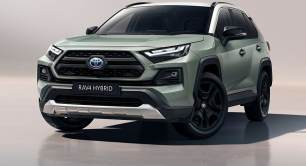In driving the new Grand Cherokee the first thing you recognise is the Pentastar V6’s characteristic induction sound. That’s not to say it’s overly loud, just familiar.
But in terms of what it delivers, nearly 90 percent of the engine's peak torque is available from 1800 to 6400 rpm, so you’ve got that mid-range pulling power which is as nice on the highway as it is around town, but also good for people that are into towing.
The eight-speed auto is nice and smooth, as well, and even though it’s a conventional torque-converter unit, manual shifts through the steering wheel paddles are quick.
Suspension is multi-link front and rear, with the top-spec Summit Reserve picking up air suspension and active damping. Major components are alloy to reduce unsprung weight but you can certainly feel the scale of this car.
It’s 5.2 metres long and weighs roughly 2.2 tonnes, so you’re guiding this sizeable machine along the road. It’s not an involving drive, we’re not in sports car territory here. But it feels stable and predictable in cornering, and body control is well buttoned-down.
The electrically-assisted steering’s weight is nice from parking speeds right up to freeway velocity, but road feel through the wheel is relatively modest.
In terms of the seating position, you do feel as though you’re sitting up and on, rather than down and in the front seats. But when it comes to support, after hours behind the wheel, including off road, the front chairs remained comfortable.
This is a big vehicle, that will often have a boat, van, or something else substantial hitched to the back of it, and the brakes are suitably specified.
Big discs are ventilated all around, clamped by two piston calipers at the front and singles at the rear, and on the off-road section of the launch drive we were by necessity leaning on the brakes for long periods of time.
You could occasionally smell that they were working hard, but the pedal remained firm all day, without a hint of fade.
Speaking of off-highway performance, as part of its development program Jeep tested this new Grand Cherokee in remote parts of Australia, with more than 60,000 km under the wheels of various prototypes. Likely a big help in setting up the local spec.
And that spec is, four-wheel drive in all models, as well as a single-speed transfer case in the Night Eagle and Limited, with the latter also featuring the ‘Selec-Terrain’ traction management system, controlling torque split (up to 100 per cent of drive to either axle), as well as the brake calibration, steering, suspension, throttle, transmission, transfer case, traction control, stability control, and ABS settings.
The Summit Reserve boasts a two-speed transfer case, with low-range reduction, as well as traction management and air suspension with electronic adaptive damping.
The air suspension incorporates five height settings - Normal, Off-road 1 (40mm lift), Off-road 2 (60mm lift), Park (46mm lower), and when in sport, Aero (21mm lower).
In typical Jeep fashion we attacked challenging fire and forestry trails on the launch drive and a couple of things emerged.
First, on street-focused tyres this car does incredibly well off-highway. And second, the ‘Quadra-Trac II’ 4x4 system with low-range capability in the Summit Reserve, combined with the crawl control function, makes a significant difference. You find yourself feeling that bit more composed and confident tackling very rough sections.
Also in the Summit Reserve, a low-set, forward facing camera allows you to see what’s actually happening at the front wheel via the central media screen, and in the Off-road 2 setting the car feels like it’s up on stilts and able to tackle anything in its way.
And for those that really want to get amongst it, the body clearance data is below.

